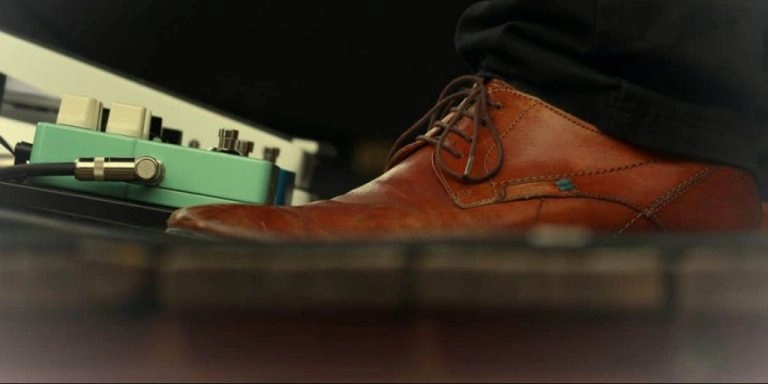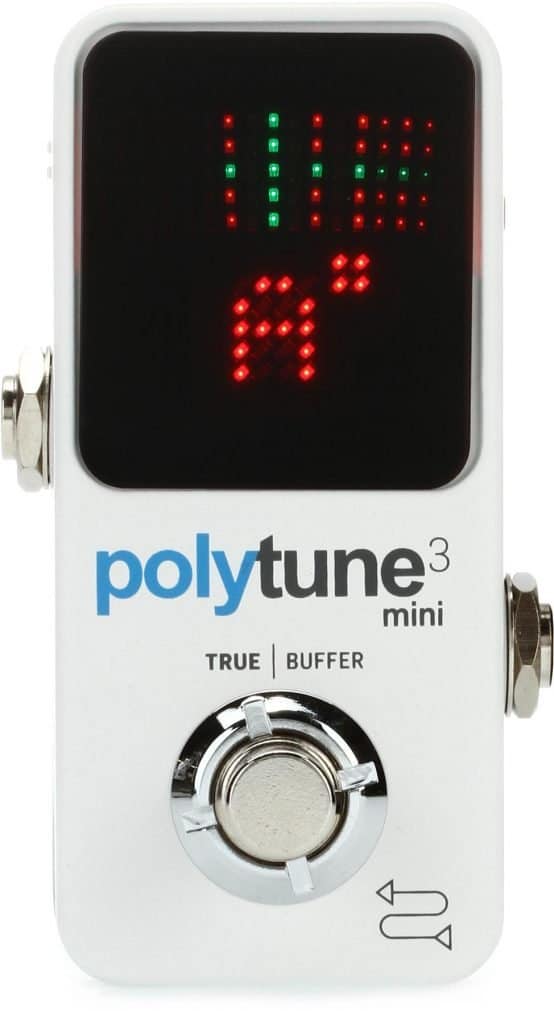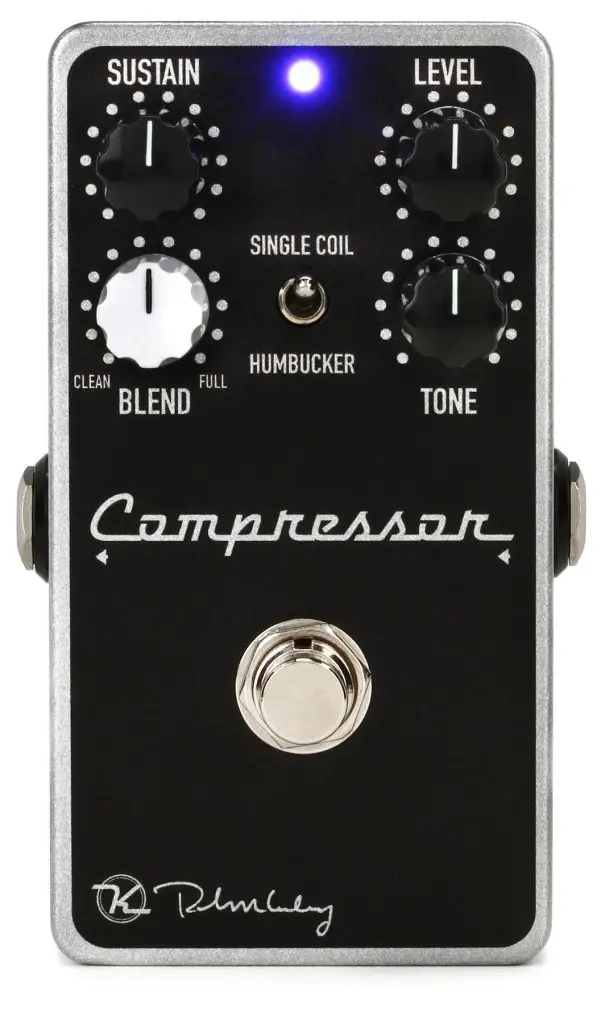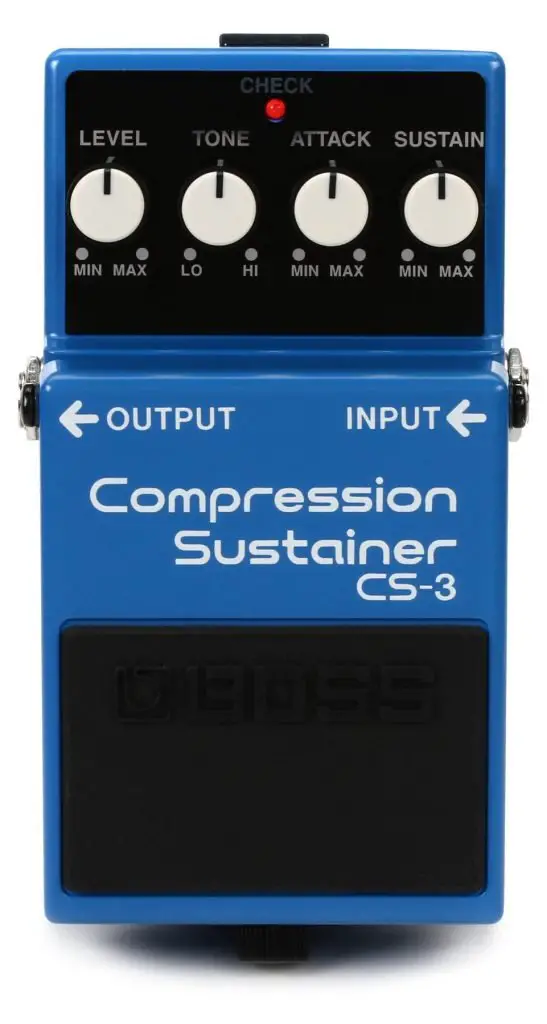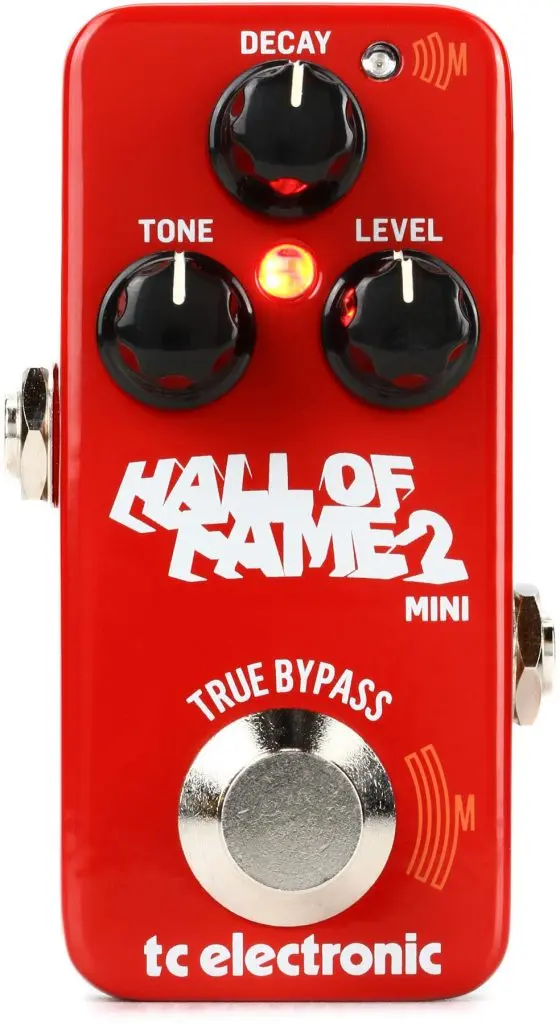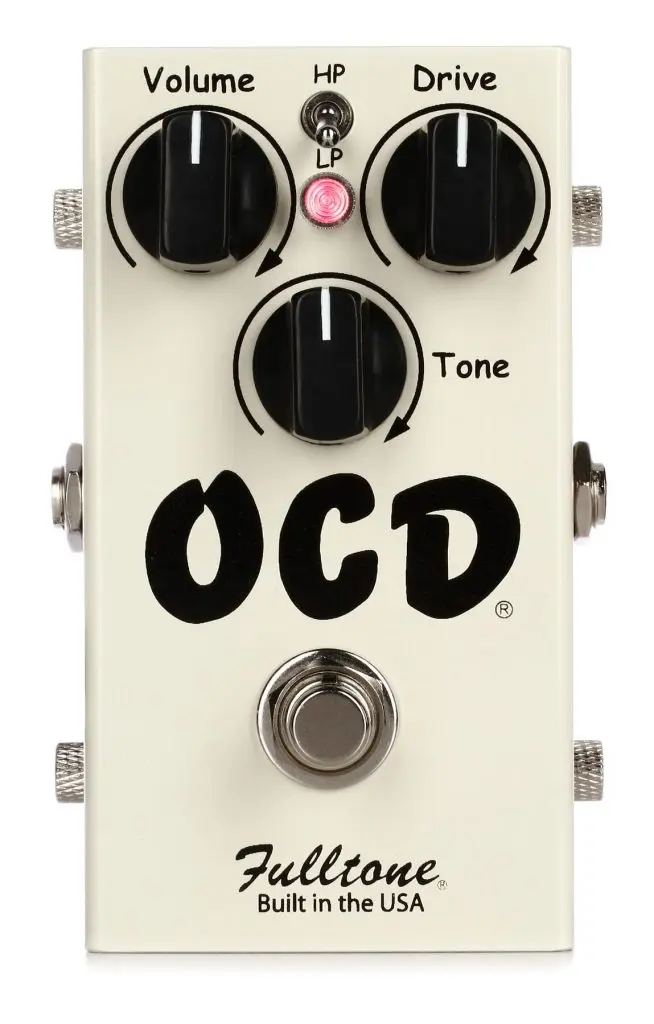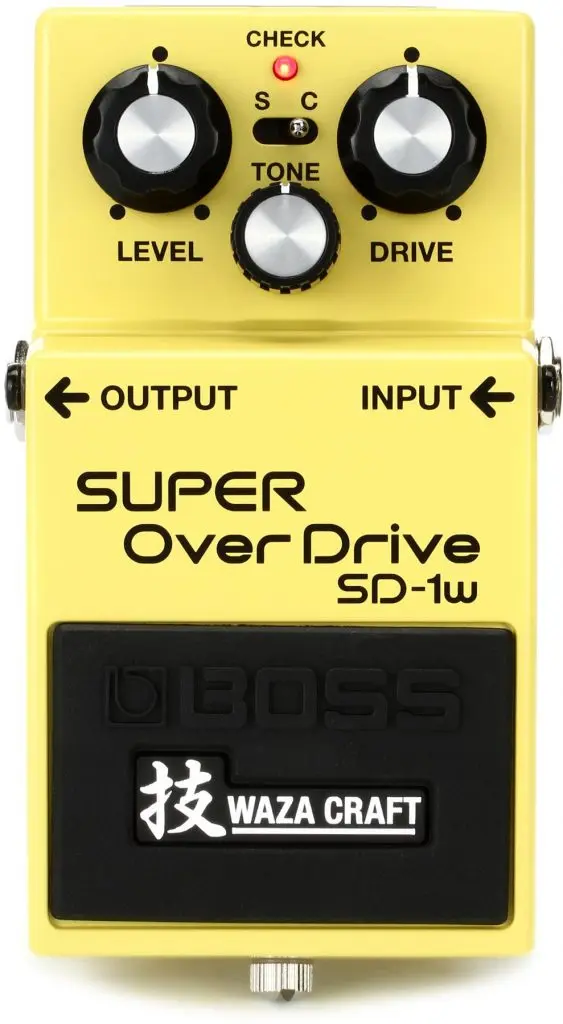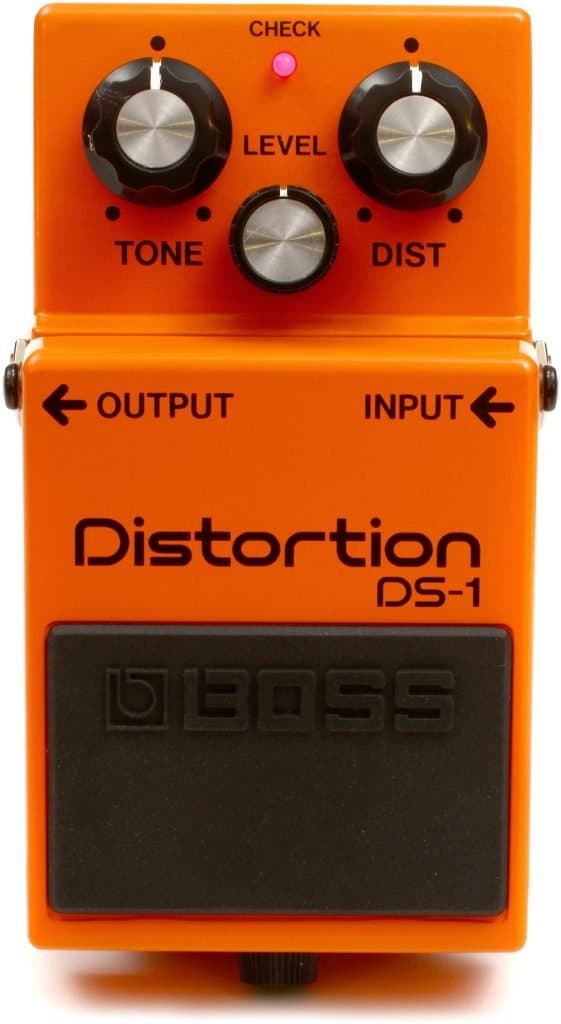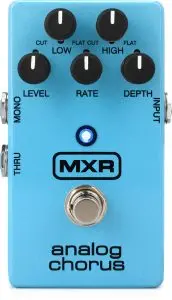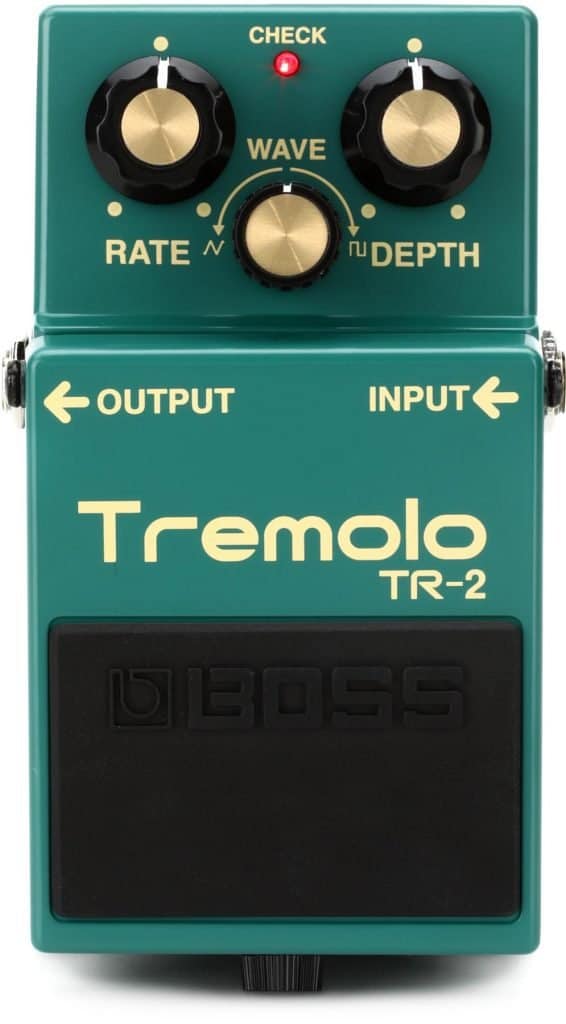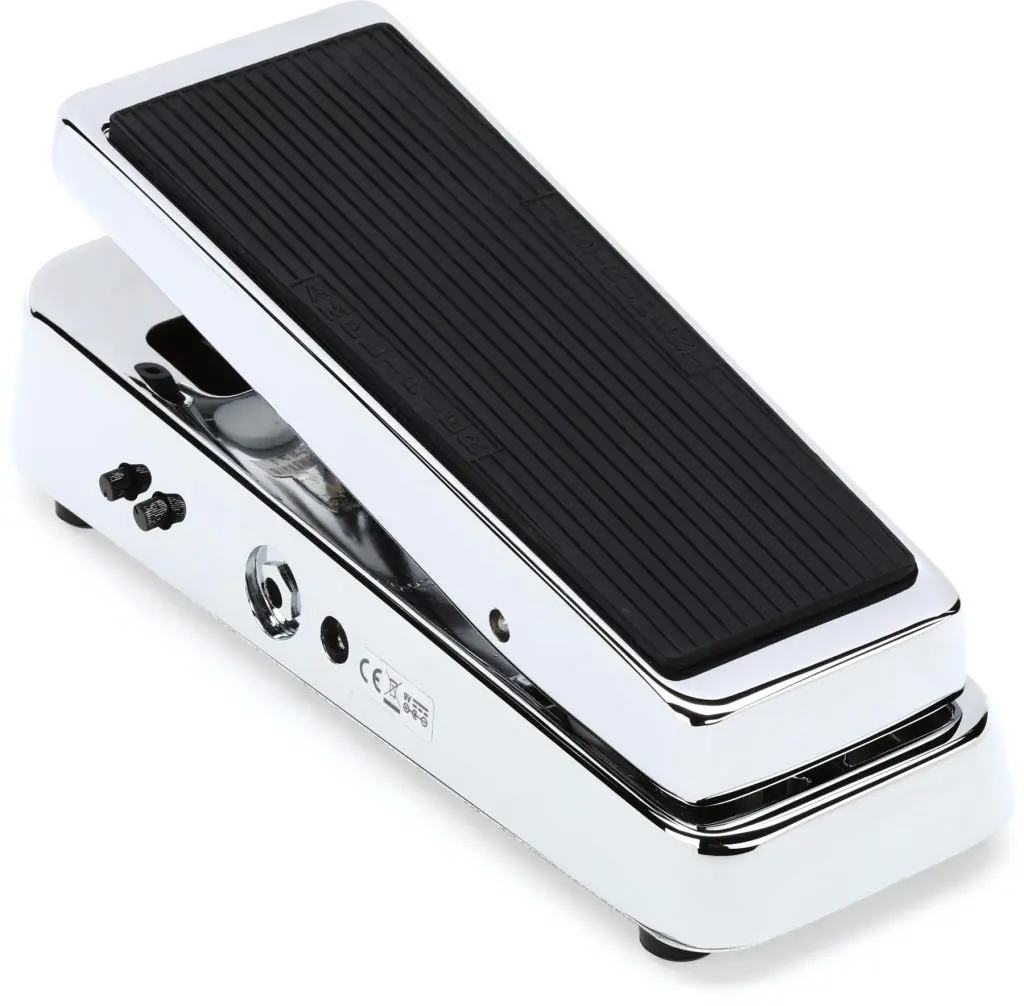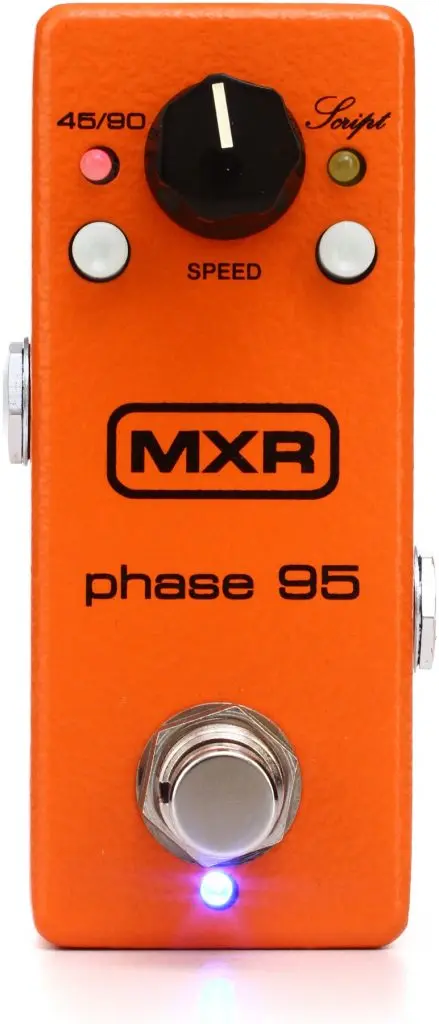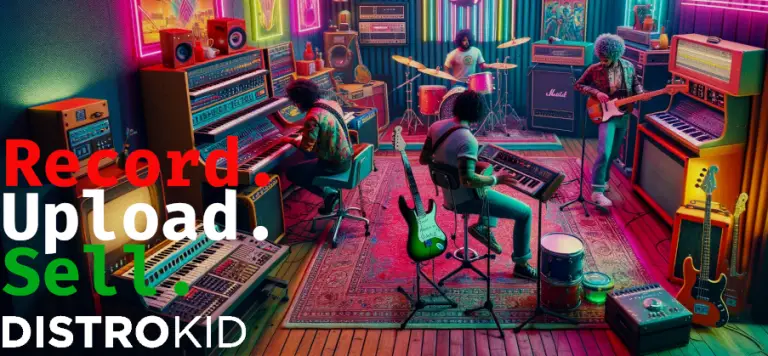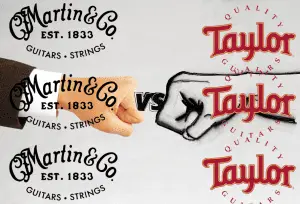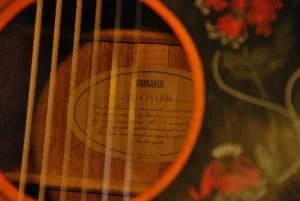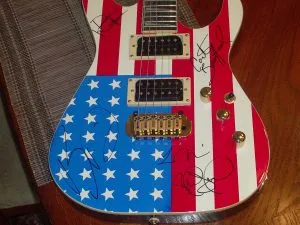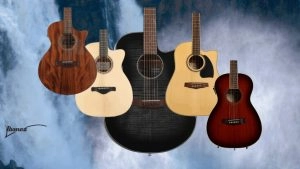If you’re in a hurry and want to cut to the chase, here’s a list of the must have guitar pedals we recommend in this article you’re in a hurry and want to cut to the chase, we recommend purchasing an “absolute must-have” kit of guitar effects pedals that includes the Boss TU-3, Wampler Ego Compressor, Boss RV-6, Boss DS-1 Distortion, and the Line 6 DL4 MkII Delay Modeler. All other pedals mentioned in this article are worthy of your purchase, but they’re not essential — especially for players who are new to guitar pedals.
As the name of our site implies, we like to keep things simple when it comes to playing the guitar, and that includes your collection of guitar pedals. After all, too much reliance on pedals isn’t the best thing when playing guitar (1).
So, we’re here to help you build a minimalist’s collection of pedals that we deem as “must have guitar pedals.”
Of course, once you start going down the proverbial guitar pedals rabbit hole, it’s hard to stop. So there’s a lot of meat in this article, but we just want to make sure you understand all of your options. Here’s a quick list of all the pedals we will review in this article:
Essential Guitar Pedals: Absolute Must-Haves
Here, we’ll go through some of the must have guitar pedals that we believe you just can’t live without.
For a minimalist approach to your pedalboard, you’ll want to focus on buying only these guitar effects pedals.
They’re more than enough to fulfill your creative endeavors.
Tuner Pedal
You can have incredible chops. But if your guitar is out of tune, your sound won’t be too impressive.
Unless you’re Tony Iommi and you’re recording Black Sabbath’s debut album! (2)
A guitar tuner pedal will also work as a mute switch if you’re changing guitars between songs on stage.
Sure, you can rely on a clip-on tuner while practicing at home or recording at the studio.
But on stage, nothing can beat the ease of use, visual clarity, and precision of a tuning pedal.
TC electronic PolyTune 3
The TC Electronic PolyTune 3 is the successor of what was the world’s first polyphonic tuner.
In strobe mode, the PolyTune 3 gives you tuning accuracy of up to 0.1 cent — 1/1000th of a semitone.
But when you’d rather tune your guitar fast than perfectly, switch to chromatic mode. You’ll be able to tune your guitar at lightning speed and still achieve accuracy within half a cent.
- Accurate. It claims to be accurate within 0.1 cents.
- All string tuning. Strum all at once to see which strings are out of tune.
- Auto dim. Your pedal won’t light up the stage if you’re playing somewhere dar
- It’s a tuner pedal. It’s definitely one of the must have guitar pedals, but not that cool.
Last but not least, the PolyTune 3 features a built-in buffer. So if you’re playing with a long signal chain, don’t worry. You won’t need a separate buffer pedal to recuperate the high-end frequencies that true-bypass pedals might be stealing from you.
But if you’d rather take care of those problems through other means, PolyTune 3 includes a switchable true bypass option.
• • •
Boss TU-3
The Boss TU-3 is also worth checking out.
It’s the successor of the world’s best-selling tuning pedal — the Boss TU-2.
The Boss TU-3 features high tuning accuracy within one cent. It has every feature you need in a tuning pedal. And its led display has a kind of retro feel to it that is kinda cool.
As an added and handy feature, the Boss TU-3 can supply power for up to seven BOSS compact effects pedal.
- Reliable brand. Boss is the go-to pedal brand.
- Drop tunings. Easily access different tunings on the fly.
- Auto mute. No one will hear you tuning on stage.
- Expensive. Over $100 for a tuner
• • •
Compressor Pedal
In technical terms, this pedal “compresses” the dynamic range of your guitar’s signal.
In plain English, it reduces the volume of the loud sounds and raises the volume of the quiet sounds from the guitar.
This will make your sound more articulate and smoother to the human ear. It’ll also boost your guitar’s sustain.
In other words, compression can make playing your guitar easier and more fun.
In the studio, a good compressor can make any guitar sound like it’s been professionally recorded.
Sure, great guitarists sound great primarily because of their talent and hard work. But most of them use compression to help themselves to a bit of magic tone juice.
So don’t be afraid to help yourself to some of it if you can afford it.
Keeley Compressor Plus
A top-notch, American-manufactured compressor with a ton of cool features.
You can adapt it to either single coils or humbuckers by changing the attack and release times with a simple switch.
The Blend control knob allows you to lower the compression level without losing sustain-boosting power.
- Blend control. Combine the dry and compressed signal to your liking.
- Amplified attack. Dial in a powerful sound quickly.
- True compression. This introduces absolutely zero noise into the signal.
- Difficult UI. This pedal takes some time to learn how to use it properly.
• • •
Wampler Ego Compressor
Yet another super high-end, super versatile, made-in-the-USA compressor. It’ll give that magic touch to your guitar’s tone for every music genre imaginable.
It’s a bit more expensive than the Keeley Compressor Plus, though. So make sure to try them out and compare them back to back before deciding which one is your favorite.
- Tube amp sound without all the extra buzz.
- True bypass. Excellent compression and sustain.
- Made in the USA. American-made products are always of higher quality.
- Pricey. American-made guitar pedals don’t come cheap.
• • •
Boss CS-3 Compression Sustainer
This one’s a bit of a cheaper option that still delivers excellent value for money.
Like so many other Boss pedals, the Compression Sustainer has been on the market forever. It’s been both harshly criticized and passionately lauded by guitar players worldwide.
Maybe you’re looking for a high-quality compressor but can live without the uber-precise fine-tuning options of more expensive units.
If that’s so, then the Boss CS-3 might be just what you’re looking for.
- Smooth sustain. And it doesn’t sound fake.
- Precise control. This is what Boss is known for — an EQ is included.
- Great low-volume noise. This isn’t easy to do, but Boss knocks it out of the park.
- Simple. Some users complain it’s too plain and there are better options on the market.
• • •
Reverb Pedal
Sure, there’ll be times when you’ll want your guitar tone raw and dry. But if you want to add a touch of echoey mystery and mystique to it, a bit of reverb is all you need. A reverb is easily considered one of the essential guitar pedals for your pedalboard.
Reverb will add room between each note you pick during your solos and each chord you strum while playing rhythm. It’ll make your sound smooth and fluid.
As mentioned above, most reverb pedals in the market today are digital. However, reverberation effects were invented using analog equipment back in the day.
Here’s a brief sketch of the classic reverb modes:
- Plate. Initially achieved by making a metal plate vibrate with transducer-generated sound waves.
- Spring. Originally achieved by making one or more metal springs vibrate using transducers.
- Hall. Emulates what you’d hear in a concert hall, theater, or a similar large venue.
- Room. Emulates the reverberation you’d hear in a room. Sound travels much faster through a room than in a hall, so the decay of this reverb is always quicker than hall.
In an effort to differentiate themselves from the competition, many reverb pedals feature additional innovative modes. Time will tell if they manage to stick around long-term like the classic modes have.
Reverb is such an essential effect that nowadays most amps come with some form of it built-in. But if your favorite amp doesn’t, here are a couple of options you should explore.
Boss RV-6
An excellent pedal at a reasonable price for guitarists of any skill level.
It features eight reverb modes, four of which are all-time classics: Spring, Plate, Hall, and Room.
The other four are custom special-effect reverb modes:
- Shimmer. It creates an oscillating, high-frequency overtone that gives it an otherworldly, fantasy-like vibe.
- Dynamic. This mode tracks the depth of the reverb effect to your playing. It accentuates the reverberation if you play louder notes and vice versa.
- Delay. Adds digital delay to the reverberation effect. It’s welcome if you don’t have the budget to buy a separate delay pedal.
- Modulate. Adds modulation to hall reverb.
- King of reverb. This is my pick for the best reverb pedal.
- Vintage spring. Make any amp sound like a Princeton Reverb with this guitar pedal.
- Auto switch. Switch tones on the fly with ease.
- Weak hall reverb. I love every sample on this pedal, minus the hall reverb.
For a preview of each reverb mode, check out the video below.
The RV-6 has dual 1/4-inch jacks for mono or stereo operation.
It also features an expression pedal jack, which allows you to control the depth of the effect with your foot.
However, the RV-6’s manual recommends Roland’s EV-5 expression pedal as the only compatible option. This isn’t exactly a cheap accessory.
Another minor drawback is the cramming of the reverb modes around a small rotary control. This makes them a bit hard to read.
• • •
TC Electronic Hall of Fame 2
This is another great value-for-money reverb pedal. It features the classic room, hall, spring, and plate reverb modes. And also more advanced modes such as shimmer, modulate, and LoFi.
It doesn’t include a delay effect at all, like the Boss RV-6 pedal. However, its footswitch functions as an expression pedal.
So unlike the RV-6, you don’t need to buy a separate expression pedal when you buy the Hall of Fame 2.
- Good value. More affordable than the Boss counterpart.
- Expressive effect. The footswitch is pressure-sensitive to allow you to control specific tones.
- Three presets. That’s typically enough for a regular gig.
- Poor customer service. A store like Sweetwater can help, but the manufacturer is tough to come by.
Another cool feature of the Hall of Fame 2 is its customizability. Three empty slots around the selector switch let you add your own custom verbs.
With TC Electronic’s TonePrint app you can download artist presets from their library. Or you can use the TonePrint Editor software to create custom reverb modes.
• • •
Overdrive Pedal
How’s an electric guitar different from a classical guitar?
More than anything else, in its capacity for producing loud sounds.
And if played loud enough, guitar amps create distortion — that crunchy, warm effect that is the lynchpin of blues, rock, and so many other modern-music genres.
Overdrive is a subtle form of distortion. It’s a natural consequence of cranking up a tube amp’s volume knob. Rockers love that tone, which is why we have overdrive pedals.
When the volume is high enough, the size of the guitar’s sound signal exceeds the capacity of the amp’s tube.
On a graph, this would look as if the peaks and troughs of the guitar signal’s waveform were clipped.
This clipping of the waveform is what spices up your guitar tone with extra harmonics, compression, and sustain.
Legendary guitarists Stevie Ray Vaughan, Jimi Hendrix, Angus Young, and John Frusciante are among the many that have used overdrive pedals as a creative tool.
This pedal emulates the sound of a cranked-up tube amp without having to raise the volume of your amp. Overdrive pedals work wonders on both tube and transistor amps.
Fulltone OCD Obsessive Compulsive Drive
This pedal has been on the market since 2004.
Fulltone claims that it was the very first overdrive pedal to use Mosfets as soundwave-clipping devices. This is supposed to increase the pedal’s sensitivity to the force with which you hit the strings.
In 2017 Fulltone launched a new version that took the pedal to a whole new level.
Cool features of the new version include:
- Output buffer. Protects your guitar’s overdriven signal from other pedals that might affect it. It’s also supposed to boost sustain.
- Better tone. Class A configured discrete 2N5457 JFET input section. Improves the interaction of the effect with single-coil and humbucking guitar pickups.
- Enhanced bypass. Turn the pedal into a buffer that recuperates the loss that other pedals in your signal chain may cause. This is similar to what the TC Electronic Polytune 3 pedal does. But Fulltone claims it rescues the lost trebles without sacrificing bass frequencies, which usually happens with other buffer pedals.
- Popular. Many rockers can choose any of the many overdrive pedals on the market, but they opt for the Fulltone.
- Great dynamic range. The innards of this pedal are excellent.
- True bypass mode. They call it “enhanced bypass.”
- Blue light. Most overdrive pedals (and other pedals) use red, so this could be confusing.
But enough of the technical stuff. The best way to appreciate the quality of this little gem of a pedal is to enjoy its sound.
If you want to do just that, check out the following demo:
• • •
Boss SD-1 Super Overdrive
This is one of the cheapest overdrive pedals on the market.
It’s a bare-bones, easy-to-use pedal that won’t break the bank.
But don’t let all that deceive you.
Like so many other Boss pedals, it has become a classic. And that’s simply because it sounds great.
- Smooth. Overdrive typically isn’t described this way, but Boss has figured it out.
- Genuine. This pedal does a nice job of taking the guitar signal and turning it into something out of a classic tube amp cranked to 11.
- Reactions. The pedal reacts to your playing in real-time, which is very high-tech.
- Difficult to use. There’s a learning curve with this pedal.
Without further ado, here’s a demo by the great Leon Todd in which he uses the SD-1 in a bunch of innovative ways:
• • •
Distortion Pedal
Distortion pedals create a more intense distortion of your guitar’s signal than an overdrive pedal. And if you weren’t aware, they are one of the essential guitar pedals you need on your pedalboard.
It’s the characteristic roaring sound of guitars that’s pervasive across modern music genres. However, it’s most heavily used, pardon the pun, in heavy metal and similar rock music styles.
(Don’t confuse distortion pedals with a fuzz pedal. A fuzz pedal clips the signal much tighter than a distortion effects pedal.)
A distortion pedal achieves this by running your guitar signal through a circuit that clips it regardless of how loud the volume of your amp is.
So distortion pedals sound great in both transistor and tube amplifiers. And your neighbors won’t call the police each time you practice your favorite hard rock and metal riffs.
Boss DS-1
Boss has sold tons of pedals in its stellar history. More than 10,000,000 worldwide.
And the DS-1 is Boss’s top-selling pedal ever.
Let that sink in.
The reason behind that phenomenal success is that the DS-1’s value for money is really, really hard to beat.
For around fifty bucks, you’ll buy a distortion pedal that pretty much revolutionized the guitar since it was introduced in 1978.
Since then, the DS-1 has earned a reputation for delivering tight, harmonics-rich distortion without altering the tonal uniqueness of different guitars and playing techniques.
This makes it a truly versatile distortion pedal. That’s why it’s been used by a wild variety of legendary guitarists in all sorts of genres. Prince, Steve Vai, Gary Moore, Joe Satriani, Kurt Cobain, and John Frusciante, to name a few.
- Classic distortion. If you want that classic distorted sound, this is your pedal.
- Awesome value. A great deal for one of the best distortion pedals.
- Proven. Players have used this same pedal for the past three decades.
- Too simple? This isn’t the best pedal if you want more control over the tone.
My favorite feature of the DS-1 is its tone control. Typically, a tone control cuts highs. But the DS-1’s increases highs and decreases lows when turned clockwise. It does the opposite when turned counter-clockwise.
This seemingly subtle difference is actually very powerful. It significantly widens the tone range you have access to. Nothing is out of reach for that little magic tone control, whether you want to dial in a rhythm sound or a lead voice.
If you use the DS-1 as a booster, the tone control is very effective for maintaining the definition of your low end—especially when using older amps that tend to sound muddy.
Here’s a demo of the DS-1:
And here’s Steve Vai raving about how “hairy” the DS-1 is:
• • •
Pro Co RAT 2
Another classic distortion pedal that’ll cover most of your bases without breaking the bank.
This little devil of a pedal is built to last physically and artistically.
Physically, because of its virtually indestructible steel enclosure.
Artistically, because it’s a great distortion pedal for rock, blues, pop, or jazz. Since it was launched in 1988, it has managed to get into the pedalboards of larger-than-life guitarists such as David Gilmour, Dave Beck, Joe Walsh, and Dave Grohl.
Its versatility also shows in the fact that it’s widely used as an overdrive and even as a fuzz pedal.
- Hard clips. Perfect for grunge rockers.
- High chance for harmonics. It’s that type of distortion.
- Flexible. Even jazz players like this pedal when they want to get a little bluesy..
- Basic design. Not a huge deal, just nothing too special about it.
Some players consider the RAT 2 sounds best with single-coil pickups. But I guess that’s more a matter of opinion than objective fact.
Also, it has a Filter knob which might be a little confusing. It works as a reverse tone knob. That is, it’ll decrease your tone’s trebles as you turn it clockwise.
This demo of the RAT 2 by JJ Tanis does a great job of showing its true colors:
• • •
Delay
Delay pedals are synonymous with echo, which happens when the sound seems to repeat after bouncing off a surface. You’ll typically hear it in an ample space, like a stadium. Delay pedals deliver that magic even when you’re playing in your own bedroom.
A delay pedal emulates this natural auditory phenomenon. That’s why a delay pedal is yet another essential, pervasive guitar effect that you’ll hear in all modern music genres.
The MXR M169 Carbon Copy Analog Delay is a great choice among the delay pedals available on the market. We review it together with a few other exciting options in our article on the best delay pedals for guitarists.
Digital delay pedals are often combined with loop pedals, allowing you to strum a few chords in time and then solo over them as your pattern continues playing.
• • •
Chorus Pedal
The chorus makes your guitar sound like it was playing along with many other guitars.
It mixes your guitar’s signal with several delayed and pitch-modulated copies of itself.
The overall effect is perhaps best described as “dreamy” or “watery.” It also creates a significant “shimmer” effect, mainly when used on higher-pitched chords.
Legendary examples of chorused guitar riffs include Nirvana’s “Come as You Are,” Metallica’s “Welcome Home (Sanitarium),” and The Police’s “Message in a Bottle.”
MXR M-234 Analog Chorus
The MXR M-234 is a fully analog pedal that uses bucket-brigade circuitry. This is huge for chorus pedals as it provides warmth and depth that digital chorus pedals simply can’t replicate.
It features the indispensable rate, level, and depth controls. But it also includes knobs that allow you to cut high and low frequencies, significantly increasing your tone-dialing possibilities.
- Real analog chorus. You can’t beat it.
- Frequency control. Dial in the highs and lows to nail the tone of your choice.
- Portable. You can find room on your board.
- No digital tones. Look elsewhere for more modern chorus effects.
To listen to its magic, check out the following demo:
• • •
Essential Guitar Pedals: Important But Not Crucial
Guitarists widely use the following pedals in many modern musical genres. But not as much as the pedals reviewed so far in this article.
So if you’re a beginner or have a relatively small budget, you might want to postpone buying any of these pedals.
Still, it’s good to keep reading to become familiar with them. You can always bookmark this page and return to it when you’re ready to expand your pedalboard.
Tremolo Pedal
The beauty and power of the tremolo effect are in its simplicity. All it does is modulate the volume of your guitar’s signal.
The result is the hypnotic sound of guitar classics such as Link Wray’s Rumble, recently revived by Quentin Tarantino’s Pulp Fiction. Thankfully, there are tremolo pedals out there that can help you replicate that sound.
My all-time favorite example of a tremolo pedal in action? Nancy Sinatra’s 1966 cover of Cher’s “Bang Bang (My Baby Shot Me Down).”
(Which, by the way, was also brought back to life in 2003 by another Tarantino film — Kill Bill).
Boss TR-2
The Boss TR-2 provides great vintage tremolo effects, and it is very easy to use.
- Surf’s up. Looking for a surfer rock tone? This is your pedal.
- Control. This model offers the best wave, rate, and depth control in tremolo pedals.
- Warranty is five years, which is great.
- Drops volume. Not a ton, but it could be annoying.
Check it out at work in the following demo:
• • •
Wah Pedal
As the name suggests, the wah pedal shapes your guitar’s signal to mimic the human voice saying “wah-wah.”
Well, at least that’s when you’re playing solos. When you’re playing funky riffs, it’s usually described as a “wacka-wacka” effect. Still, you can replicate this sound with a wah pedal.
Controlling the intensity of the “wah” is a matter of making the pedal oscillate when you alternate the pressure between heel and toes.
Eric Clapton and Jimy Hendrix were the first guitarists to use the wah pedal in the studio in the 1960s.
Here’s a great video by Paul Davids showing many of the most common uses of the wah pedal:
And here’s John Petrucci showing more unconventional techniques on his wah pedal:
• • •
Dunlop Crybaby Multi Wah
The Dunlop Crybaby is by far one of the leading wah pedals in the marketplace.
Its use is so widespread among guitarists of all genres that “crybaby” and “wah pedal” have pretty much become synonyms.
In 1985, Jim Dunlop acquired the patent of the wah pedal from Jim Plunkett, who invented it in 1966.
- Best in the business. You mention wah, and you’ll get a recommendation for a Dunlop.
- Durable. It’s built like a tank and can handle any gig.
- Customizable. Dial in the ultimate wah sound.
- Expensive. The best isn’t cheap.
And in the early ’90s, Jim’s son, Jimmy Dunlop, took the pedal to a whole new level. He made it highly flexible and customizable, and it’s stayed that way ever since.
• • •
Phaser Pedal
The phaser pedal creates a sweeping effect in the sound signal.
You can use it to create a cybernetic-like sound. It was used, for instance, to make the original voice of C-3PO in Star Wars.
However, when used with a guitar, perhaps it’s more accurate to say that the phaser infuses your sound with a psychedelic vibe.
MXR Mini Phase 95
MXR is pretty much the iconic brand when it comes to phase pedals.
Its reputation is mainly due to Eddie Van Halen’s use of an MXR phaser. Most notably in the band’s first album.
- Two-in-one. A combination of the Phase 95 and the original Phase 90, which you can switch between.
- Compact. It won’t take up much room on your board.
- Great value. Under $100.
- Lacks blend control. Some find the effect a bit much.
My favorite example from Van Halen I is the riff of “Ain’t Talkin’ ’bout Love.”
“Atomic Punk” also shows a tremendous yet more extreme use of the phaser:
The MXR Mini Phase 95 is a compact little phase pedal that packs enough power to make you sound like Eddie. Without breaking the bank!
• • •
Volume Pedal
If you’re a gigging musician, a volume pedal, like the Dunlop DVP4, is one of the convenient guitar pedals you’ll want to have.
In addition to silencing your guitar, a volume pedal can let you create cool effects for solos and rhythm playing.
• • •
Guitar Pedals for Beginners: A Buyers Guide
If you’re new to guitar, you’re new to guitar pedals. Don’t fret, though! (See what we did there?) Learning how to best use guitar pedals isn’t that difficult — it’s a lot of trial and error.
Of course, we first recommend taking guitar lessons to better your playing skills before jumping head-first into the world of pedals. But if you’re itching to try out some of the best guitar pedals, here are some things you should know.
Sound Quality
The indisputable physical fact is that software can’t match the sound quality of analog guitar pedals (3).
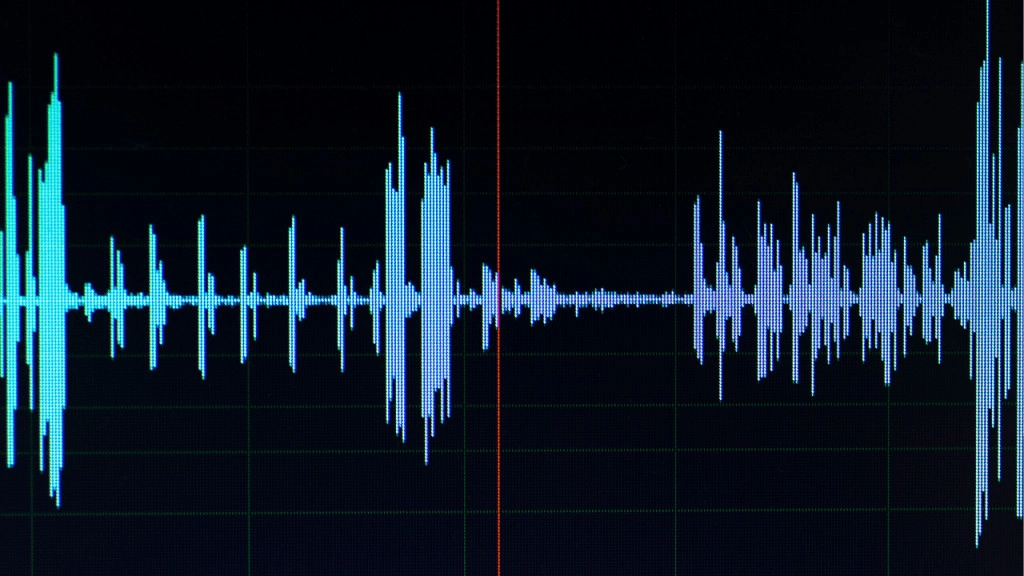
But is the quality difference at all perceptible by the human ear?
This is a particularly relevant question in an era of lightning-fast technological progress.
However, it’s still a source of endless debates. And many professional and lay audiophiles swear they definitely can hear the difference.
In the end, it all comes down to preference and budget.
If you’re just getting started on your guitar journey on a tight budget, by all means, take the VST-route.
But you, like so many of us, might be able to notice the natural, organic superiority of analog sound over digital. If so, you should start building your pedalboard as soon as your budget allows.
That’s why most of the pedals we have reviewed in this article fall into the analog category.
Aesthetics and Mystique
Art is primarily an aesthetic experience.
And the aesthetic quality of playing the guitar is not limited to sound quality. It also has to do with visual aspects.
Beautiful gear enhances the aesthetic experience you’ll deliver to your audience on stage. It will make playing the guitar more pleasurable. It will boost your inspiration and help you become a better player.
And for many of us, the look and feel of a computer are no match for the beauty of a pedalboard.
Even uber-shredders say the color of a guitar pedal influences their decision to use it.
Take, for instance, Paul Gilbert:
There’s also a whole tactile dimension to this.
Turning physical knobs on your pedals to dial in your sound is an entirely different experience than manipulating a computer.
If you ask me, changing the settings of your effects with a mouse simply feels weird.
Paul Davids explains it quite well in this short video:
Guitar Pedals vs. Multi-FX Unit
Again, you could very well go for a multi-FX unit instead of going through the hassle of creating a pedalboard from scratch.
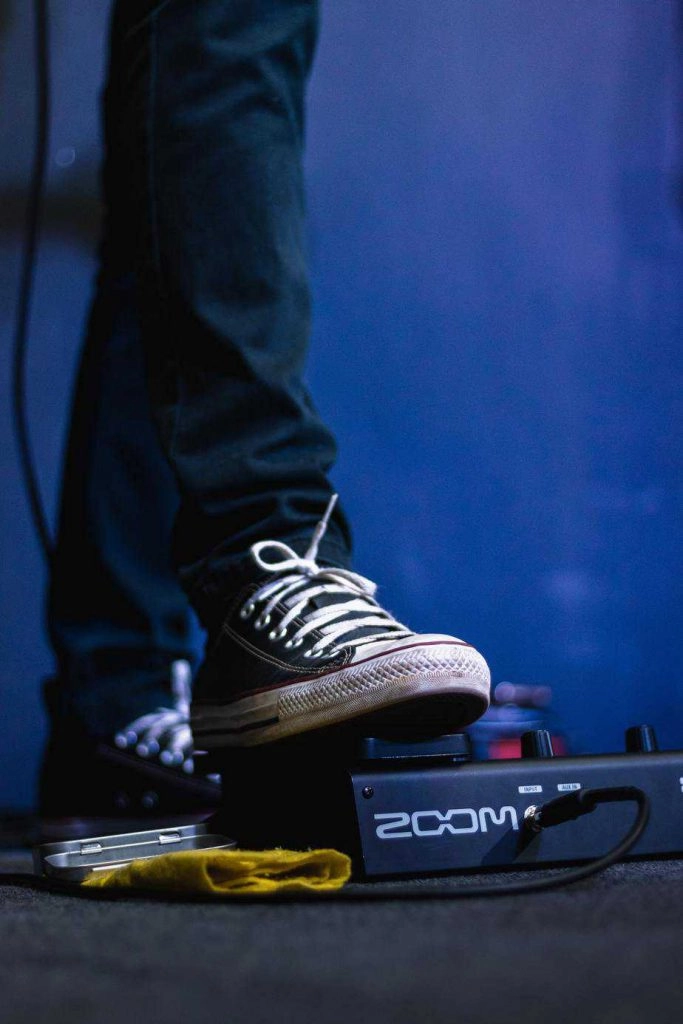
These units are usually more expensive than going full VST. But they can still save some money compared to purchasing the equivalent guitar pedals one by one.
Again, it all comes down to preference, aesthetics, and mystique.
On the one hand, many of the effects in multi-FX units are digital. If you don’t like how some of these effects sound, you can’t replace them like you would replace a pedal.
Also, pushing buttons and reading text on small LCDs to dial in your sound might feel weird.
You might find it more comfortable and fun to turn knobs in good ol’ stompboxes. And that’s a simple, valid reason to prefer guitar pedals.
Do I Need to Build a Guitar Pedalboard?
If you’re going to have a collection of guitar pedals, you want to have a nice system to keep them organized. The best way to keep everything from your distortion pedals to your favorite fuzz pedal organized is by using a pedalboard.
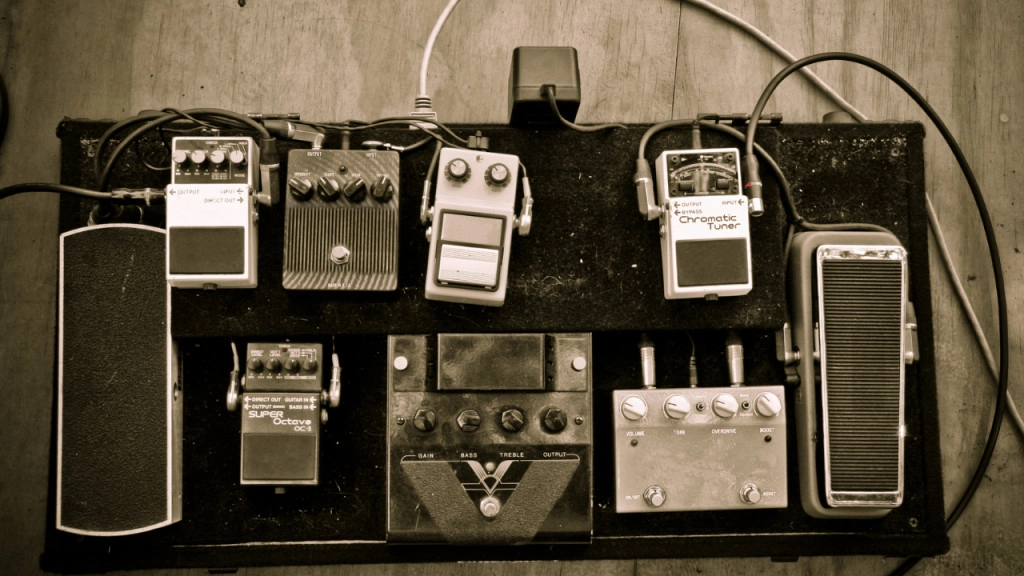
Simply put, a pedalboard allows you to comfortably access all of your guitar pedals — and with ease. A pedalboard is also quite helpful in keeping all your cords organized. This is especially important for gigging musicians who need to set up their equipment quickly.
Some handy musicians build a pedalboard on their own, while others prefer to purchase a pre-made board, like this popular option by Pedaltrain.
Thankfully, today’s pedals are relatively compact, allowing you to easily place 5-10 pedals on a single board.
Find Your Guitar Pedals
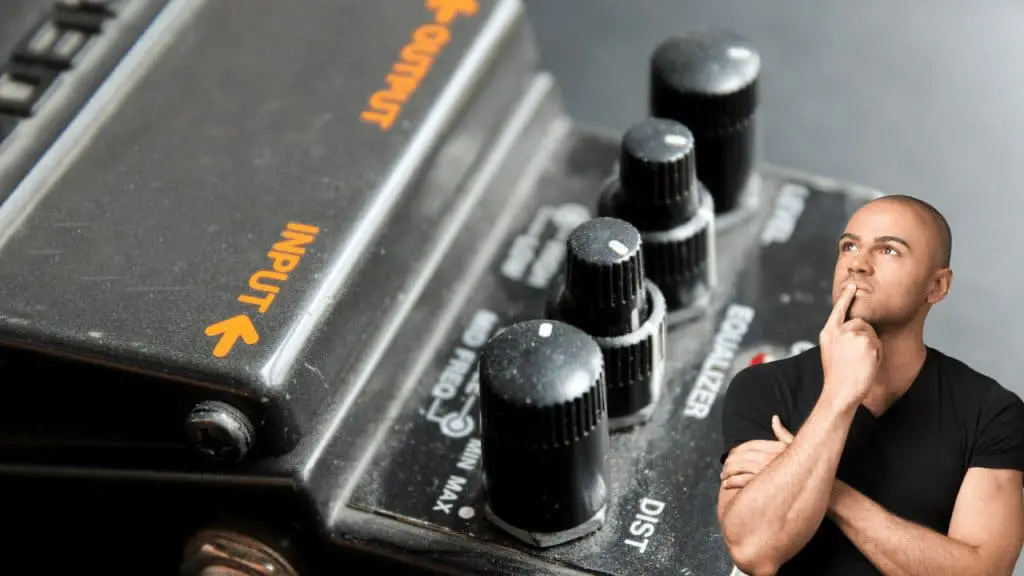
I didn’t cover all the types of pedals you may want in your rig. Fuzz pedals, for instance, didn’t make the list because they’re too close to distortion and overdrive. That being said, fuzz pedals, and a flanger pedal, are pretty cool effects you shouldn’t ignore.
The point is that there are many different guitar pedals out there that alter your guitar signal for the better or worse. As you develop into a better player, you’ll want to experiment more. And who knows, maybe you’ll be into fuzz pedals, delay pedals, or whatever tickles your fancy. There are some innovative pedals out there that might fit your style (4).
To wrap things up, here’s a great video by Jamey Arent taking full advantage of a small pedalboard with several of the effects reviewed in this article. It does an excellent job of putting together everything we’ve talked about:
• • •
References:
- Reverb, “Joe Bonamassa Calls Pedalheads ‘Lazy’ in Interview,” as published here https://reverb.com/news/joe-bonamassa-calls-pedalheads-lazy-in-new-interview
- Guitar World, “Steve Vai once told Ozzy Osbourne the first Black Sabbath album was out of tune – Ozzy’s response? “What the f**k do you want?”,” as published here: https://www.guitarworld.com/news/steve-vai-once-told-ozzy-osbourne-the-first-black-sabbath-album-was-out-of-tune-ozzys-response-what-the-fk-do-you-want
- How Stuff Works, “Does digital sound better than analog?,” as published here ;
- Sam Kemp, “The 5 most innovative guitar pedals” as published here https://faroutmagazine.co.uk/five-most-innovative-guitar-pedals/

